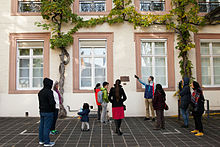Walking tour

A walking tour is a tour of a historical or cultural site undertaken on foot, frequently in an urban setting.[1] Short tours can last under an hour, while longer ones can take in multiple sites and last a full day or more. A walk can be led by a tour guide, as an escort.
Precursors[edit]
A pilgrimage is a religious journey traditionally taken on foot, to a location of significance to the walker's faith. Chaucer's 14th-century narrative poem Canterbury Tales certainly indicates that a pilgrimage can involve pleasure.
The Camino de Santiago route to the shrine of the apostle Saint James the Great in the cathedral of Santiago de Compostela in Galicia in northwestern Spain is a famous example, and remains popular today.
In Iraq, the Shia Muslim 20-day Arba'een Pilgrimage to Karbala attracts many millions of pilgrims each year.[2][3][4]
The Grand Tour, undertaken in Europe in the 17th through 19th centuries, as part of a wealthy young man's education,[5] involved visits to cities, historic and cultural sites.
There are also similarities between walking tours that involve long hikes and backpacking.
Tours of cities and cultural sites[edit]


With guides[edit]
A walking tour is generally distinguished from an escorted tour by its length and the employment of tour guides, and can be under 12 hours, or last for a week or more. They are led by guides that have knowledge of the sites, or the landscape, covered on the tour, and explanations and interpretations of the site can cover a range of subjects, including places with historical, cultural and artistic significance. Walking tours, of various kinds and length, are universally part of the tourism industry, and can be found around the world.
Many walking tours involve a payment to the guide, although some operate on a tip system.[6] The "pay what you want" model started around 2004, and can be found in many countries. The UK-based Guild of Registered Tour has criticised the system for not requiring any training or certification of its guides.[7]
Narratives[edit]
Several cities now have groups that are employing dramatic spectacle to add interest to their tours. Usually guided by actors in costume playing a role, these walking tours create the feel of living history as guests walk in the footsteps of those who came before them. These tours, which blend history and dramatic narrative, share "history in a non-academic, very accessible fashion."[8]
These tours are similar in nature to promenade theatre. Although the theatrical nature of these tours is similar to museum theatre in that it makes use of first person interpretation, the fact that these tours take place outside of traditional museum settings and requires the audience to move through urban environments makes this style of walking tour a genre of its own.[citation needed]
Self guided tours[edit]
Self-guided tours, utilise a range of methods to aid travel through a place, or landscape, such as books,[9][10] maps, pamphlets, and audio material.[11]
Day tours with specific locations[edit]
- Boston By Foot (Boston, USA)
- Big Onion Walking Tours (New York City)
- Photowalking
- Caminhada Noturna, São Paulo
See also[edit]
References[edit]
- ^ Article title[dead link] Oxford Dictionary 1
- ^ Dearden, Lizzie (25 November 2014). "One of the world's biggest and most dangerous pilgrimages is underway". The Independent. Archived from the original on 25 September 2015. Retrieved 4 October 2015.
- ^ Philipson, Alice (2015-01-19). "The ten largest gatherings in human history". The Telegraph. Archived from the original on 6 October 2015. Retrieved 3 October 2015.
- ^ Chandra Kharel, Gopi (13 December 2014). "Arbaeen 2014: 20 Million Pilgrims Flock to Karbala [PHOTOS]". Ibtimes. Archived from the original on 4 October 2015. Retrieved 4 October 2015.
- ^ The Canadian Oxford Dictionary (1998), and New Oxford American Dictionary.
- ^ Molnar, Agnes (2014-04-25). "Strassenökonom – die Stadtführerin". Capital (in German). G+J Wirtschaftsmedien GmbH & Co. KG. Retrieved 2016-01-25.
- ^ Baker, Vicky (2013-06-12). "The rise of the 'free' city tour". the Guardian. Retrieved 2016-01-25.
- ^ Handley, Gen. "Forbidden Vancouver tour reenacts Gastown's gothic adventures". The Westender. The Westender. Retrieved 11 June 2015.
- ^ Frommer's walking tours. Paris, Prentice Hall Travel, 1993, ISSN 1081-3381
- ^ Legarde, Lisa (1993), Frommer's walking tours. San Francisco, Prentice Hall Travel, ISSN 1081-3403
- ^ Wooldridge, Denyse. (Narrator); Dee's Audio Walking Tours (1996), Manhattan Midtown West, Dee's Audio Walking Tours, retrieved 19 April 2013
Further reading[edit]
- MacCannell, Dean. The Ethics of Sightseeing. University of California Press, 2011.
- Pond, Kathleen Lingle. The Professional Guide: Dynamics of Tour Guiding. New York: Van Nostrand Reinhold, 1993.
- Ruitenberg, Claudia W. "Learning by Walking: Non-Formal Education as Curatorial Practice and Intervention in Public Space." International Journal of Lifelong Education 31, no. 3 (2012): 261-275.
- Wynn, Jonathan R. The Tour Guide: Walking and Talking New York. Chicago: The University of Chicago Press, 2011.
- Wynn, Jonathan R. "City Tour Guides: Urban Alchemists at Work." City & Community 9, no. 2 (June 2010).
